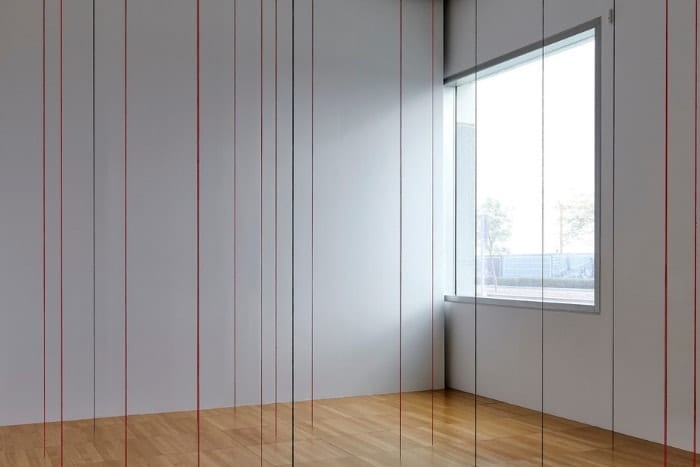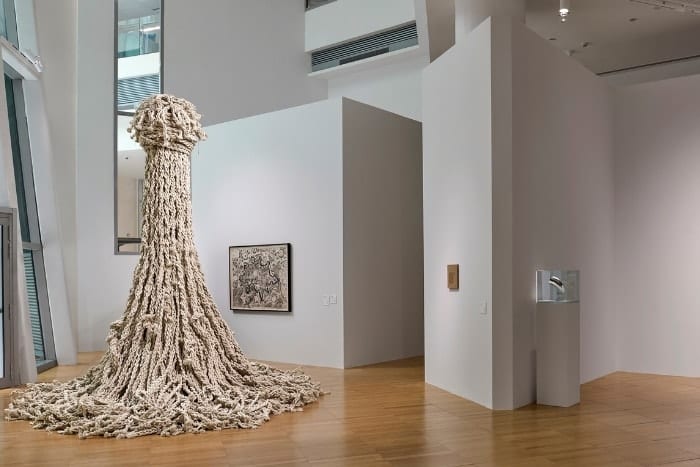Art can be intimidating. However, the Ways of Seeing Exhibition at NYU aims to demonstrate there are many ways to experience art.

Picture yourself in a grand illusion; in this case, walking through a Fred Sandback installation composed of vertical red and black-coloured acrylic yarn and wire in a stark white room.
“Is this art? It’s just lines of string,” you might ponder from the door.
Then, you walk in. “Can art make you feel woozy,” you ask?
Maya Allison, Executive Director, NYUAD Art Gallery says, “Yes, it can. No two people ever experience art in the same way, which makes this your unique experience with the installation.”
Just how does walking through a room with string tied floor to ceiling make you feel unsteady?
Allison explains, “Sandback explored space and how we carry our bodies through it. The vertical lines tap into our lizard brains and test our perception of both space and orientation. This installation challenges us more physically than intellectually than others,” Allison says sympathetically.
The atmosphere in the installation has a transcendental quality. Within it and with a guide’s help, you realize that you’re not just walking through artwork, your unique experience in the artwork is the desired outcome or indeed the artwork itself. Ponder that for a second.
What is on Exhibition?
The 41 artworks exhibited in Ways of Seeing and their placement in relation to each other around the gallery are designed to make you question space, time, and your role in artwork both as a passive viewer and active participant.
The central idea of the exhibition is that there are many different ways to regard art and where and when we see an artwork and who we are will affect what we see.
The exhibition takes its cue from John Berger’s seminal text Ways of Seeing, which challenged people’s ideas about how we regard art. The novel invites readers to understand the world differently, “the relation between what we see and what we know is never settled,” Berger wrote.
Beyond Fred Sandback’s installation, NYUAD’s exhibition presents countless opportunities to be challenged by what you are looking at, and Maya Allison proposes that visitors wander the gallery first without reading the synopses to experience the artworks without preconceived notions or advance knowledge about the artwork. She says, “they are not all exactly what they may seem on first look, which makes the exhibition so interesting.”
The range of artworks and media is vast. There is everything from sculpture to installation to videography and paintings to portraits to photography.
The artists represented are Ghada Amer, Frédéric Borgella, James Casebere, David Claerbout, Salvador Dali, Hans-Peter Feldmann, Andreas Gursky, Mona Hatoum, Paul and Marlene Kos, Alicja Kwade, Lateefa bint Maktoum, Gustav Metzger, Shana Moulton, Vik Muniz, Grayson Perry, Michelangelo Pistoletto, Fred Sandback, Markus Schinwald, Hassan Sharif, Cindy Sherman, Jojakim Cortis and Adrian Sonderegger, John Speed, Thomas Struth, Kim Tschang-Yeul, James Turrell, and James Webb.
See art in a new light when you visit NYUAD Art Gallery. Challenge yourself and your understanding of art by visiting Ways of Seeing. This exhibition is certain to open up a challenging art dialogue.
Ways of Seeing has English and Arabic-language curator-led tours. The exhibition runs until 17 November and features a full program of public events, including talks, workshops, and family-friendly activities.
NYU Abu Dhabi Art Gallery is FREE and open to the public everyday 12-8 (except Sundays).
Have an Artful Family Day
Maya Allison also suggests that parents invite their children to share their opinions on what is being represented in the artwork as they meander the gallery.
Kids have fewer references to draw from and may be less inhibited to share their thoughts than adults might for fear of appearing uninformed and being wrong.
Allison also offers that within the Gallery, there is a nice room where beverages and comfy seats are provided if families with young children need a break whilst exploring the Gallery.

The Book That Inspired the Exhibition: About Ways of Seeing
John Berger opens his influential 1972 novel Ways of Seeing with an observation that seems counterintuitive, considering its status as a written text: that, as we inhabit the world, we constantly perceive it, only later naming the things we see, making language insufficient for conveying the way we see the world.
One way that people can recreate their way of perceiving the world is through images. This term is used to describe paintings, photographs, films, or any other representation that humans can construct, and it is assumed that every image externalizes its creator’s way of seeing.
Another way of phrasing this: all images are encoded with ideology, regardless of whether their creators consciously want them to be.
Yalla recommends having a quick look at the book before or after your visit to explore this way of thinking about art.

